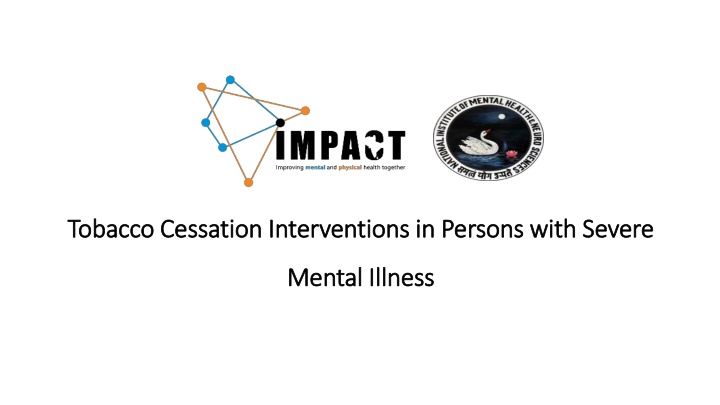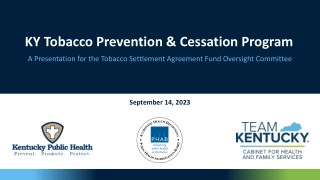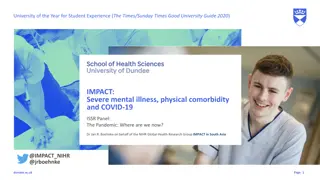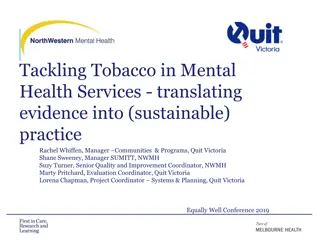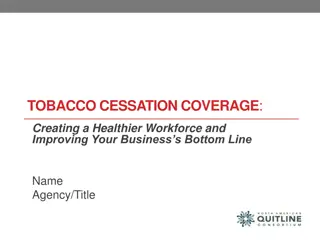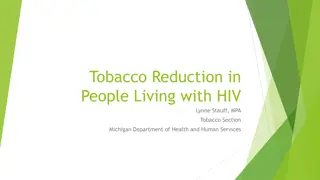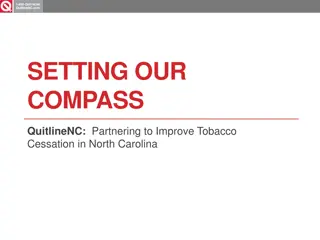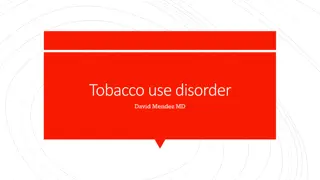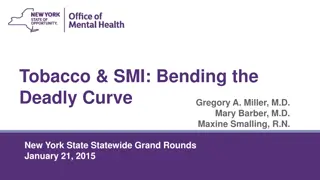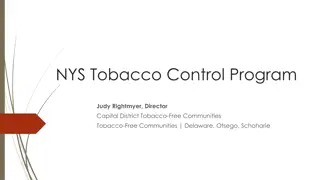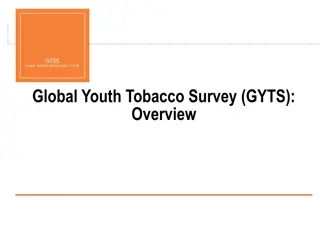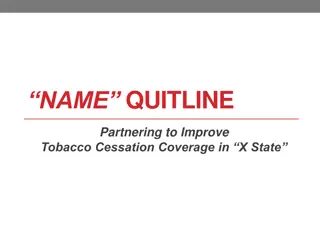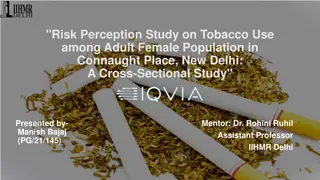Tobacco Cessation Interventions in Severe Mental Illness
Individuals with severe mental illness face health and socioeconomic disparities, often compounded by tobacco use. Tobacco is a major contributor to global morbidity and mortality, disproportionately affecting low and middle-income countries. High tobacco prevalence is observed in people with SMI, necessitating targeted cessation programs due to the lack of extended benefits from general smoking cessation interventions.
Download Presentation

Please find below an Image/Link to download the presentation.
The content on the website is provided AS IS for your information and personal use only. It may not be sold, licensed, or shared on other websites without obtaining consent from the author.If you encounter any issues during the download, it is possible that the publisher has removed the file from their server.
You are allowed to download the files provided on this website for personal or commercial use, subject to the condition that they are used lawfully. All files are the property of their respective owners.
The content on the website is provided AS IS for your information and personal use only. It may not be sold, licensed, or shared on other websites without obtaining consent from the author.
E N D
Presentation Transcript
Tobacco Cessation Interventions in Persons with Severe Tobacco Cessation Interventions in Persons with Severe Mental Illness Mental Illness
Background Background People with severe mental illness (SMI) face huge health and socioeconomic inequalities With twice the mortality and 10-25 years lower life expectancy Because of coexisting physical disorders,due to adverse lifestyle choices
Background Tobacco use is the leading modifiable contributor to morbidity and mortality worldwide Causing seven million deaths Approximately six million as a result of direct tobacco use 890 000 as a result of being exposed to second-hand smoke.
80% of deaths will be in low and middle income countries (LMICs) 40% of deaths occurring in working age adults It causing significant loss to economic productivity.
In India 28.6% of all adults use some form of tobacco The smoking prevalence being approximately 10% for all adults 21 % of the adult population in India use smokeless tobacco.
Tobacco use in SMI Tobacco use in SMI Tobacco use prevalence is particularly high in people with SMI, with estimates ranging from 50-90%. Smoking prevalence among SMI is estimated to range from 40 to 60%. South Asian studies suggest smoking prevalence as high as 50% among people with SMI.
In India 36% of adults with psychiatrist illness reported tobacco use moderate to severe nicotine dependence, with 65% of all users (Beedis, Cigarettes, Chewing tobacco) (Chandra et al, 2005)
Smoking is one of the most common modifiable unhealthy behaviours among people living with SMI, benefits of smoking cessation programmes have not been extended to this population
There has been almost no reduction in smoking prevalence among people with SMI, even in high income countries (HICs) Despite the dramatic reduction in smoking rates in the general population that has occurred during the past 40 years. The reasons for this include diagnostic overshadowing
Schizophrenia 33.64%, mood disorders -33.33% (any form - inpatients) More than three fourths had markedly severe illness Dependence moderate to severe 80 to 90 % case records did not document diagnosis (Amol, 2017, unpublished)
Interventions (behavioural and Pharmacological) Behavioral support interventions 1.Brief interventions A. The 5 As for smoking cessation intervention: 1. Ask about tobacco use: 2. Advise to quit: 3. Assess willingness to make a cessation attempt: 4. Assist in cessation attempt: 5. Arrange follow-up:
B. Recommendations to enhance motivation to quit tobacco: the 5 Rs 1. Relevance: 2. Risks: 3. Rewards: 4. Roadblocks: 5. Repetition:
C. STAR to prepare to quit tobacco or smoking S - Set a cessation date T - Tell family, friends, and co-workers about quitting and request understanding and support. 3) A- Anticipate challenges to the planned cessation attempt R - Remove tobacco products from his/her environment
D. Brief counselling/ advice E. Motivational interviewing/ interventions
MI is direct, patient-centred counselling intervention guided by four general principles: 1. expressing empathy, 2. Developing discrepancy, 3. Rolling with resistance and 4. Supporting self-efficacy
F. Cognitive behavior therapy(CBT) Assessing the good and not so good aspects of smoking, Setting goals, outlining a treatment plan, personal triggers and high-risk situations, planning to stop smoking, introduction to coping with urges cognitive restructuring, reviewing withdrawal symptoms, discussing the use of nicotine replacement therapy, identifying and challenging unhelpful negative thoughts,
Reviewing cognitive strategies and skills enhancement, development of personal skills and problem solving skills Coping skills training (cigarette refusal skills training, assertiveness and communication skills development, stress management) Relapse prevention and lifestyle modification
The BCTs will include goal setting, problem solving, social support, information about health consequences and adding objects to the environment.
Pharmacotherapy Pharmacotherapy Nicotine replacement therapy (NRT): o Nicotine patch; o Nicotine gum; Bupropion Varenicline
The integration / combination of behavior support interventions and drug they have showed more effective. Home visits and telephonic follow up
Challenges Training Time Human resources Advise events of drugs No immediate change physical health Availability and accessibility of services
Goals Complete smoking abstinence Reduction in the number of cigarettes or biddies they smoke Rely on self or family report Biochemical measures (Urine cotinine and CO Monitor)
Tailored smoking-cessation interventions developed in HICs but not LMICs Differing patterns of tobacco use, diet, health service provision, and regulatory approaches from an HIC cannot be directly translated to a LMICs.
The cultural perceptions of smoking may also differ between Western countries and countries in South Asia. In addition, many of the currently existing smoking-cessation studies among people with SMI have been judged to be low quality in general, and this needs to be strengthened.
Smoking cessation support for people with severe mental illness in South Asia
Aim To adapt an evidence based, combined behavioural and pharmacological support intervention for smoking cessation among adults with SMI and test the feasibility and acceptability of delivering and evaluating it
Objectives To test the feasibility and acceptability of delivering the IMPACT 4S intervention for smoking cessation among people with SMI
Objectives To test the feasibility and acceptability of carrying out a definitive trial to evaluate the effectiveness and cost-effectiveness of the IMPACT 4S intervention for smoking cessation among people with SMI
Method Randomised controlled pilot and feasibility trial Outpatients with severe mental illness 86 patients in each country Mental health facilities in India (NIMHANS) and Pakistan (IOP)
Inclusion criteria Adults ( 18 years old) with SMI (Clinically stable) from Bangalore Self-reported current smoker (6 months) on >25 days in the past month Willing to cut down/quit smoking, attend 10 face to face sessions
Exclusion criteria Pregnant or breastfeeding women Comorbid drug and/or alcohol problems Epilepsy
Development of the intervention SCIMITAR+, TB & Tobacco, Tobacco use: A Smart Guide 3-5 intervention development workshops Intervention modules and manuals
Intervention Brief advice: Five minutes, face-to-face, one-to-one smoking cessation counselling session and an information leaflet
IMPACT 4S intervention: Up to 10, 45 minutes face-to-face, one-to-one smoking cessation counselling sessions Its 4S consist of 3 steps: 1) preparation, 2) quit date and 3) life after quitting
Breath CO monitoring and feedback, pharmacotherapy (bupropion and/or NRT), and an information leaflet
